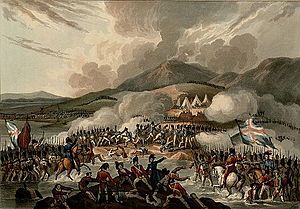Battle of the Bidassoa (1813)
| Battle of the Bidassoa (1813) | |||||||
|---|---|---|---|---|---|---|---|
| Part of Peninsular War | |||||||
 Battle of the Bidassoa, 9 October 1813. |
|||||||
|
|||||||
| Belligerents | |||||||
|
|
|
||||||
| Commanders and leaders | |||||||
|
|
|
||||||
| Strength | |||||||
| 62,000 | 89,000 | ||||||
| Casualties and losses | |||||||
| 1,676, 17 cannons | 825 | ||||||
In the Battle of the Bidasoa (or the Battle of Larrun) on 7 October 1813 the Allied army of Arthur Wellesley, Marquess of Wellington wrested a foothold on French soil from Nicolas Soult's French army. The Allied troops overran the French lines behind the Bidassoa River on the coast and along the Pyrenees crest between the Bidasoa and La Rhune (Larrun). The nearest towns to the fighting are Irun on the lower Bidassoa and Bera on the middle Bidasoa. The battle occurred during the Peninsular War, part of the wider Napoleonic Wars.
Wellington aimed his main assault at the lower Bidasoa, while sending additional troops to attack Soult's center. Believing his coastal sector secure, Soult held the right flank with a relatively weak force while concentrating most of his strength on his left flank in the mountains. However, the British general obtained local intelligence that indicated that water levels on the lower river were much lower than the French suspected. After careful planning, Wellington launched a surprise assault which easily overran the French left flank defenses. In the center, his army also won through the French defenses, though his Spanish allies were repulsed in one attack. At the beginning of the fighting, Soult realized that his left flank was in no danger, but it was too late to reinforce his positions on the right. Some French generals were shocked at how poorly their soldiers fought.
In the Battle of San Marcial on 31 August and 1 September 1813, Soult's army was repelled in its final bid to advance into Spain. After a costly assault followed by a brutal sack of the city, the Allies also brought the Siege of San Sebastián to a successful conclusion in early September. A French garrison held out in the Siege of Pamplona which would end in a surrender on October 31. Wellington determined to create a bridgehead across the Bidassoa River. If successful, his army would be the first Allied army to establish itself on French soil. The British commander also wanted to capture French positions that overlooked the Allied lines on the west side of the Bidassoa.
...
Wikipedia
